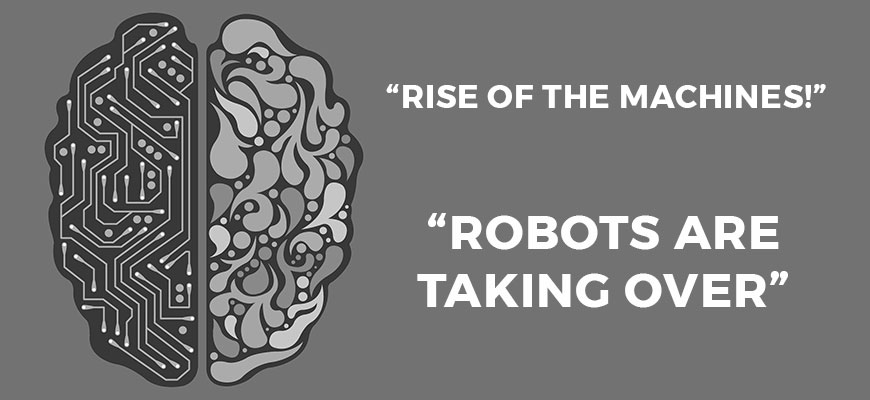
Creating your own Rocket Industrial personal account has many benefits:

Although these headlines may sound like something from a futuristic movie, they are real headlines from current day articles. There is a sense of discomfort people feel when discussing the very real fact that automation technologies could very well replace thousands of workers. There’s also a cool factor to it, as there is with any new innovation. Google, Uber, Lyft, Ford, and other automakers are all in a race to perfect the self-driving car. It’s exciting, but there’s also the possibility that when it finally does become safer for a car to drive its self rather than be human operated, truck drivers, taxi drivers, bus drivers could become irrelevant jobs.
"Automation
is Voldemort: the terrifying force nobody is willing to name."
- Jerry Michalski,
Founder of The Relationship Economy Expedition
Look around your own workplace; you’re sure to find various equipment and software that didn’t exist 10 years ago, 5 years ago or maybe even a year ago. Technology is advancing and as it continues to advance it becomes less expensive to implement. It’s becoming easier for all sizes of companies to invest in software and equipment to make their business more productive.
Some people, including Elon Musk and Bill Gates, have expressed concern over the future of automation and worry that technology will destroy jobs faster than it can help create them. On the other side of the spectrum, many economists strongly believe progressive technology is not malicious, in fact it will benefit workers and industries. While more mundane tasks become automated, there will be an increased need for support staff, sales and marketing, engineers, and production workers for more complex tasks.
"What the
machine takes away, it also gives back with entirely new industries, entirely new types of
jobs."
- Malcolm Frank, author of What To Do When Machines Do Everything
Look back at employment history in the United States. 100 years ago, there was widespread fear that the development of the automobile meant the loss of many labor jobs. Instead the auto industry created opportunities for thousands of new job markets. Another example is the farming industry. In the late 1800s, over 80% of Americans were working on farms. Today that number is less than 2%.

If you would like to see the estimated automation risk level for your job, head over to willrobotstakemyjob.com to find out.
Advances in automation are allowing companies to create new machines that are less costly and offer an increased ease of entry. In some cases, the ROI timespan on equipment is shortening from years to months. This is good news for manufacturers since they are currently facing a worsening problem: the shortage of skilled manufacturing labor. Over the next decade nearly 3.5 million manufacturing jobs likely need to be filled. Due to the widening skills gap, 2 million of those jobs are expected to go unfilled. The Manufacturing Institute and Deloitte found that four out of five U.S. manufacturers are willing to pay more than current market rates in attempt to hire and retain employees. Many companies will be facing the same dilemma choosing between doing everything in their power to attract workers or begin to automate processes. Often times, it's becoming economically more attractive for companies to implement automation and robotics rather than investing heavily in building up a labor force, especially for manufacturers that need to up productivity for growth.
64% of work
in the manufacturing industry has the potential to be automated.
- McKinsey Global Institute
Not many facilities will be able to eliminate humans completely. In adidas's SPEEDFACTORY, much of the production is done by machines, but human assistance is still necessary. Adidas has been dealing with labor shortages, as well as issues with the length of its supply chain. The goal of the automated factory is to shorten the time it takes to design, produce, test, and get shoes in the stores using fast, integrated, flexible machines. Workers will still be needed to do precise tasks, such as shaping and lacing shoes, as well as staff to monitor software and equipment.

Safety
According to the Bureau of Labor Statistics, there were approximately 2.9 million nonfatal workplace injuries and illnesses reported by private industry employers in 2015, but there was also a decline in the rate of injuries in the manufacturing industry. We will continue to see injury rates decline as the number of companies using automation grows. Ensuring employee health and safety is just as important as maximizing productivity and efficiency.
"The most
prominent driving factor regarding the future and growth of robotics is, and will continue to be,
safety."
- Mike Debroux, Automation and Robotics Engineer at Rocket Industrial
Robots, cobots, and other automation equipment are especially useful (and welcome) for redundant, tedious end-of-line operations. These technologies are not only increasing productivity and efficiency, but are also assisting in improving workplace health and increasing safety in facilities. Routine handling functions that can lead to issues such as carpel tunnel or cause strain on the back and neck are a great fit for automation. Innovative solutions will continue to arise that promote an ergonomic workplace and optimize workflow.
The growth of automation adaption may eliminate certain jobs, but to quote the great Aaron Rodgers, relax. As technology advances and tasks begin to be automated, workers will reallocate to tasks that require creativity, cognitive thinking, and social intelligence. We need to focus on automation bringing opportunities, not threats to the workplace. New jobs will be created, possibly even new industries, just as it has happened in the past throughout history.
Related articles:
• 6 Factors to Consider Before Automating
• Packaging Wars - Robot vs Cobot